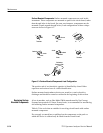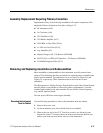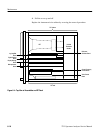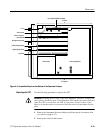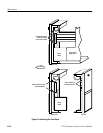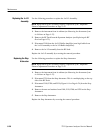
Maintenance
6-20
2715 Spectrum Analyzer Service Manual
3. Disconnect the CRT anode lead and discharge it to the main chassis.
WARNING. The CRT anode lead retains a high voltage charge after the instru-
ment is turned off. To avoid electrical shock, ground the anode lead to the main
chassis immediately after disconnecting.
4. Disconnect the two pin connector (Trace Rotation) from J930 on the Power
Supply board.
5. Use a T15 Torx driver to remove the two CRT bezel screws, and remove the
bezel.
6. Remove the CRT rear cover and plastic shield.
7. Disconnect the CR T socket.
8. Slide the C RT out through the front panel.
Replace the CRT by reversing the removal procedure.
The trace rotation coil is part of the CRT assembly. If the coil is damaged beyond
repair, the CRT with the damaged coil must be replaced.
If the finish (red) lead is broken, remove the tape and unwind one or two turns so
it can be replaced and soldered to the lead wire. Rewind and retape.
If the start (black) lead is broken and the lead is too short to resplice, attempt to
fish out the broken end so one or two turns can be unwound, resplice and solder
to the lead; then rewind and retape.
In all three instances, the CRT must be removed from the instrument.
Performance of the instrument is easily degraded if coaxial connectors are loose,
dirty, or damaged. The following procedure will help ensure that the connection
is good enough to maintain proper performance.
1. Use a 5/16 inch open end wrench to loosen or tighten the connectors. It is
good practice to use a second wrench to hold the rigid (receptacle) portion of
the connector to prevent bending or twisting the cable.
2. Ensure that the plug and receptacle are clean and free of any foreign matter.
3. Insert the plug connector fully into the receptacle before screwing the nut on.
Tighten the connection to 8 in-lb to ensure that the connection is tight. Do
not overtighten, because this can damage the connector.
Replacing the CRT Trace
Rotation Coil
Replacing Semirigid
Coaxial Cables





